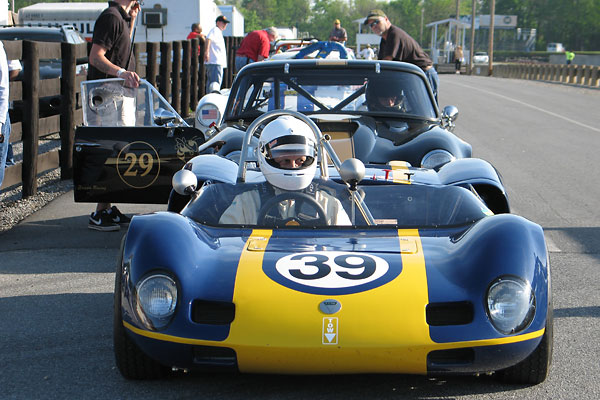
Bernard Bradpiece's 1963 Elva MkVII Race Car
Owner: Bernard BradpieceCity: Annapolis Maryland
Model: 1963 Elva MkVII
Engine: Lotus Twin-Cam 1.6L
Race prepared by: Lee Chapman Racing
Elva's MkVII Model
Elva introduced their MkVII model in time for the 1963 season. It was a development of
the previous MkVI, but with many important upgrades including for example disc brakes.
Production of the MkVII would continue through 1965 before being phased out in favor
of the MkVIII, which is easily distinguishable because it's both wider and longer.
Initially, the MkVII chassis came in one basic version designed to support Coventry Climax and
Ford 1.1L four cylinder engines. The Ford Lotus Twin-Cam was just becoming popular, and the
MkVII chassis would accept it. At least twenty-nine original MkVIIs were produced.
However, customer demand for larger displacement and more powerful engines compelled Elva to
produce an uprated version which they named "MkVII S". The MkVII S could be purchased with
Lotus Twin-Cam, Porsche, or BMW engines with displacements up to two liters.
Production of Porsche-powered MkVIIs is reckoned at 19 cars, and at least fifteen
BMW-powered MkVII were built too. Add the numbers up and you get a little uncertainty!
Elva's total MkVII production came to at least 69 cars, and some people give the total
production number as 71 or 72. Possibly the higher figures include replacement frames
or cars sold in otherwise incomplete configurations.
Besides their larger engines, what other features differentiate a MkVII chassis from a
MKVII S chassis? We'll discuss them when we're ready to publish our photos of a MkVII S.
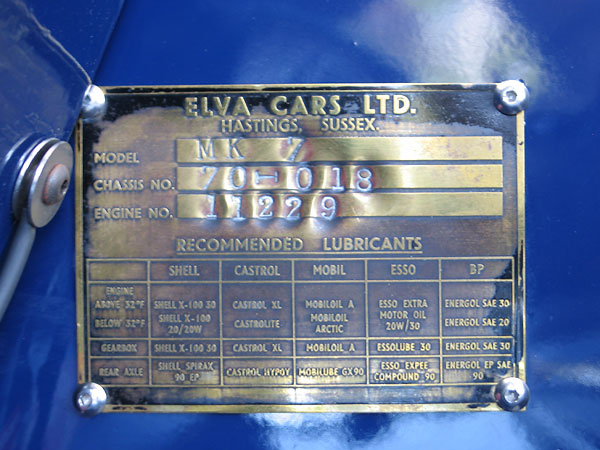
ELVA CARS LTD. - Hastings, Sussex
Model: "MK 7" - Chassis No: "70-018" - Engine No: "11229"
Before Bernard Bradpiece acquired his Elva MkVII, it had been stored for about 40 years.
Bradpiece hired Lee Chapman, Pat Prince, and Ted Wenz to manage various aspects of the car's
extensive restoration. Their work spanned about three years, and was completed shortly before we
photographed the MkVII at Vintage Racer Group's 2010 Jefferson 500, an annual event held at
Summit Point Motorsports Park in West Virginia. How did the newly restored Elva do?
Bradpiece won his races on both Saturday and Sunday! In Saturday's 12-lap sprint race,
Bradpiece lapped the very technical 2.0 mile circuit in 1:22.179 for an average
speed of 87.614, ultimately winning the race by a 32.6 second margin.
Features and Specifications
| Engine: | Ford-Lotus Twin-Cam 1.6L engine.
27316015 (Cortina MkII) engine block.
Dual Weber 45DCOE carburetors.
Weber TLK1/W throttle linkage assembly.
ITG Tri-Foam air filter.
Lucas distributor.
Lucas AB14 electronic ignition amplifier.
Pertronix Ignitor breakerless ignition module.
Lucas Sport ignition coil.
Moroso Blue Max 8mm spark plug wires.
JAE Racing electronic rev limiter.
Dry sump lubrication system.
Fuel Safe custom engine oil reservoir.
Coopers AP2658 (replaceable element) oil filter assembly. |
| Cooling: | dual custom aluminum crossflow radiators, plumbed in parallel.
Mocal OC1447-12 (44-row) oil cooler. |
| Exhaust: | custom four-into-one header featuring stainless steel collector and tailpipe. |
| Transaxle: | Hewland Mk9 five speed transaxle. |
| Front Susp.: | unequal length unparallel wishbones.
KONI aluminum-bodied double-adjustable coilover shock absorbers.
Reproduction Elva pattern magnesium front uprights from Lee Chapman Racing.
Modified Triumph Herald steering rack.
Non-adjustable anti-sway bar. |
| Rear Susp.: | inverted lower wishbones, single top links, and twin radius arms.
KONI aluminum-bodied double-adjustable coilover shock absorbers.
Reproduction Elva pattern magnesium rear uprights from Lee Chapman Racing.
Adjustable anti-sway bar. |
| Brakes: | (master) dual Girling master cylinders with bias bar and remote reservoirs. (front) Girling AR calipers, with solid rotors. (rear) Girling D12R (or D14R) aluminum calipers, with solid rotors. |
| Wheels/Tires: | reproduction Elva magnesium racing wheels from Lee Chapman Racing (13x6 front and 13x7 rear.)
Avon racing tires (5.0/22.0/13 front and 6.5/23.0/13 rear.) |
| Electrical: | PowerSafe SBS sealed lead acid battery.
Nippondenso alternator.
Tilton Super Starter. |
| Instruments: | (left to right)
Smiths water temperature (0-120C) gauge,
Stack tachometer (0-12000rpm),
Smiths dual oil pressure (0-160psi) and oil temperature (30-120C) gauge. |
| Fuel System: | Fuel Safe custom aluminum fuel cell.
Facet Bendix-style electric fuel pump.
Holley adjustable fuel pressure regulator. |
| Safety Eqmt: | Willans 6-point cam-lock safety harness.
SPA AFFF fire suppression system.
SPA quick release steering wheel hub on a Moto Lita steering wheel. |
Engine Installation
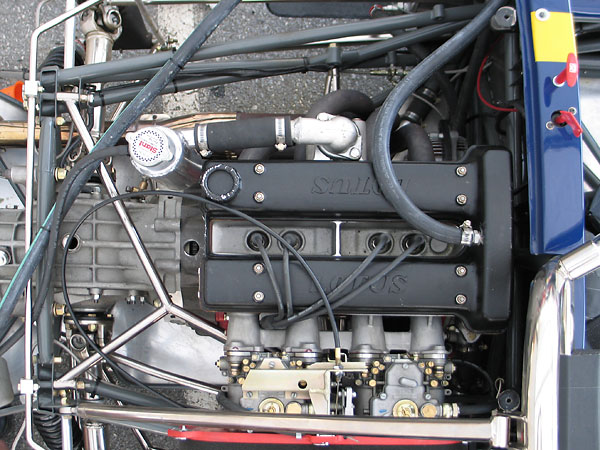
Like most racecars of its type, this Elva Mk7 has been re-powered at least once. We frankly don't
know whether it was originally built with a Coventry Climax engine, a Ford Cosworth 1.1L engine,
or a Lotus Twin Cam (as shown here). Nowadays, the Twin Cam option seems most popular. About
34,000 Twin Cam engines have been built, which helps to keep them a cost effective alternative.
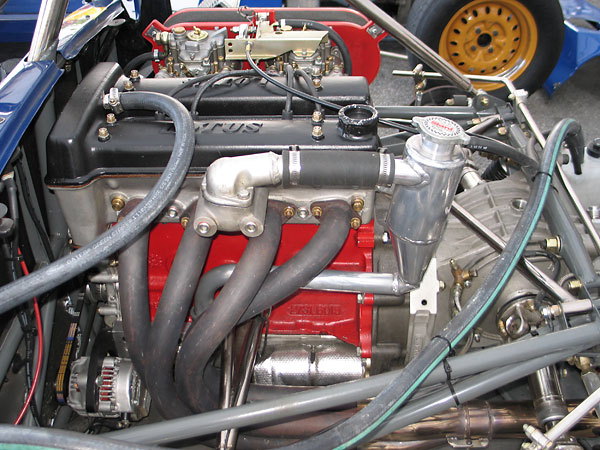
A Tilton Super Starter has been wrapped in a thermally protective blanket. Just above it, in this photo
the engine block casting number reads "27316015". This casting number indicates that this particular
engine was built for a MkII Ford Cortina. The MkII Cortina was in production from 1966 through 1970.
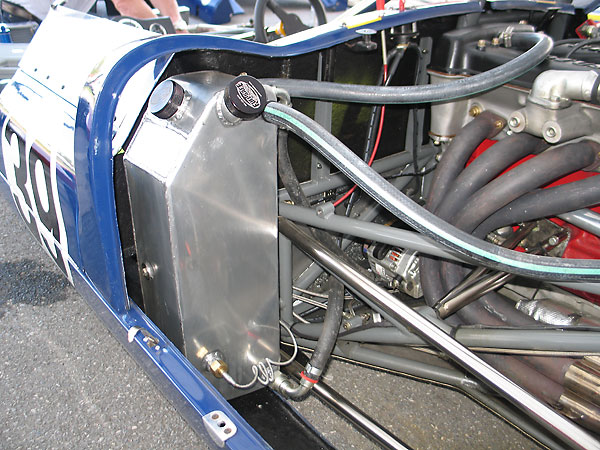
Fuel Safe custom engine oil reservoir.
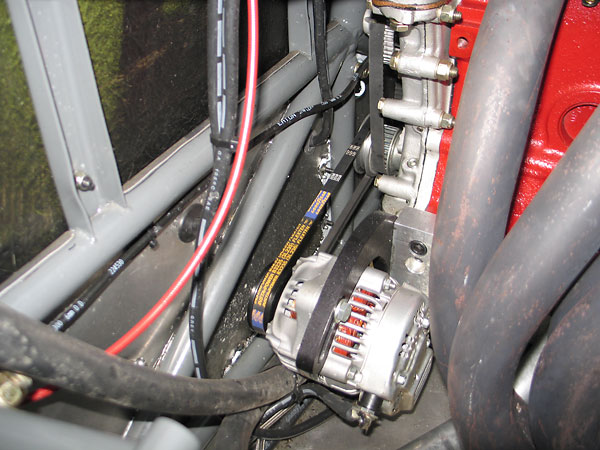
An extra volt or two for the ignition system can be a very good thing. This tiny, modern
Nippondenso alternator provides that extra power discretely and probably very reliably.
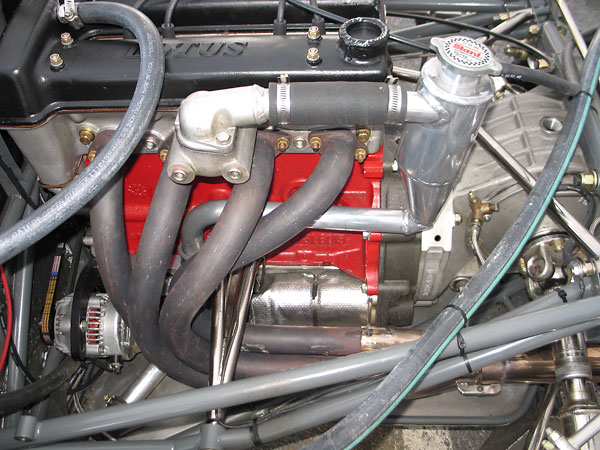
This unusual custom four-into-one header has mild steel flanges and primaries in combination with a
stainless steel collector and tailpipe. Notice that there are slip joints at both ends of the collector.
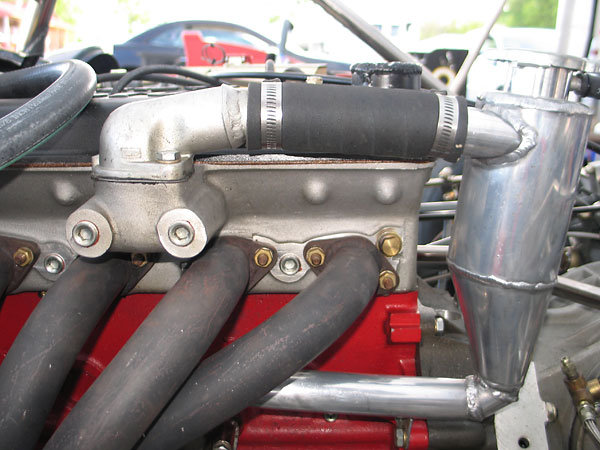
Custom fabricated aluminum coolant swirl tank.
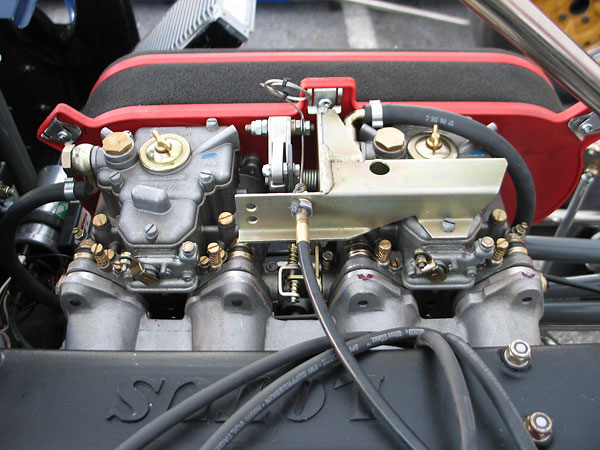
Dual Weber 45DCOE carburetors and Weber TLK1/W throttle linkage assembly.
(The Weber catalog says TLK1/W is for a single carb, but it works equally well for two.)
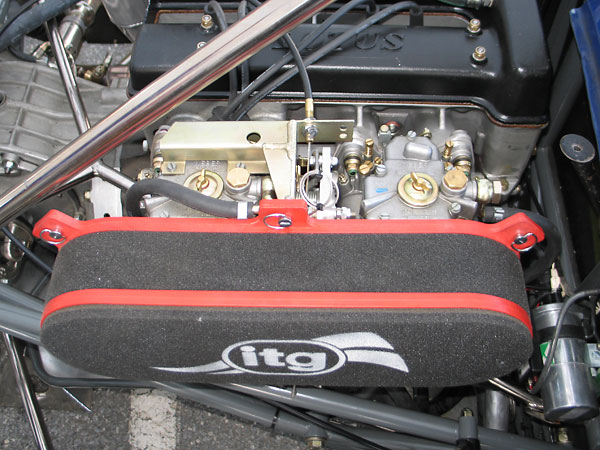
ITG Tri-Foam air filter, made from three layers of reticulated foam (of various thicknesses) arranged from
coarser to finer. The idea is that coarse dust will stop on the outside layer. Smaller particles that pass
the outer layer(s) will get trapped inside. These filters are designed to be washed and re-oiled.
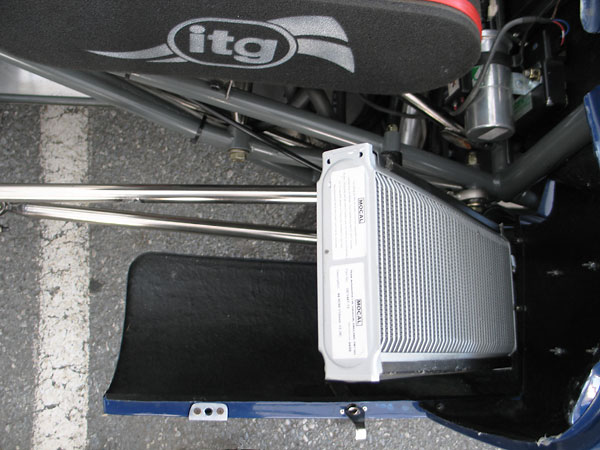
Mocal OC1447-12 (44-row) aluminum oil cooler, installed without ductwork.
Priority has evidently been given to supplying cooler induction air.
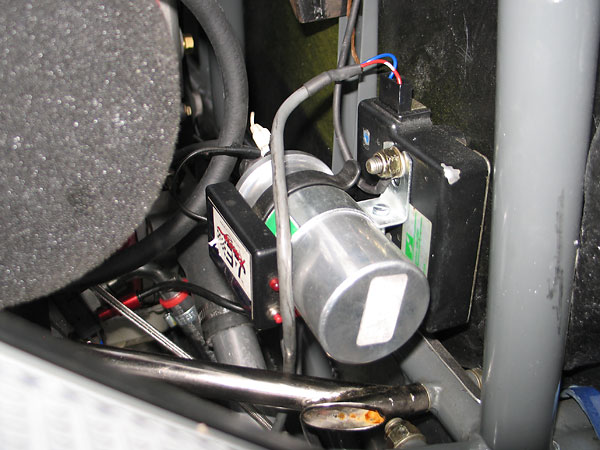
JAE Racing electronic rev limiter, Lucas Sport ignition coil, and Lucas AB14 electronic ignition amplifier.
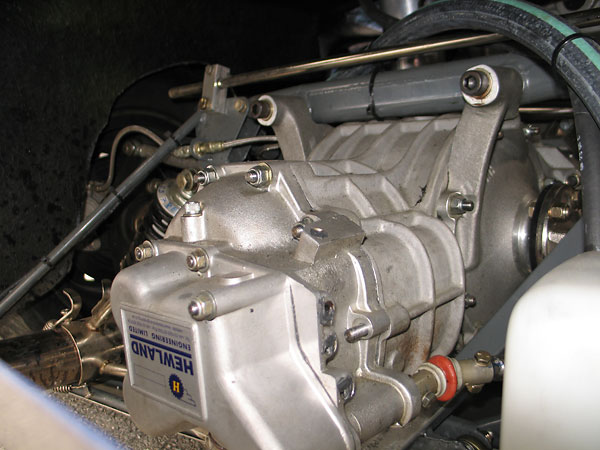
Hewland Mk9 five speed transaxle with late-model aluminum case (not a magnesium VW housing.)
Front Suspension
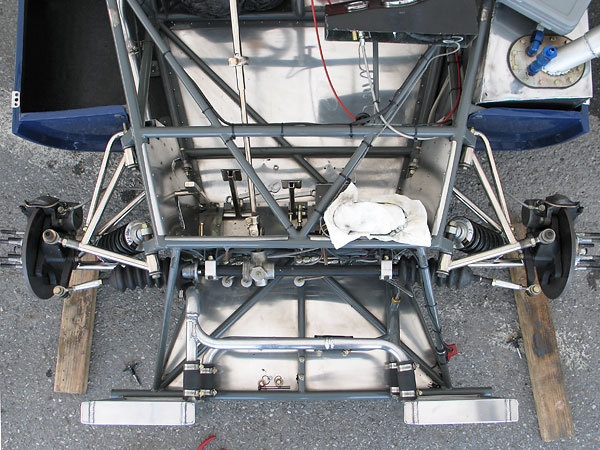
The front bodywork mounts and hinges on the tube that the radiators sit on. (PIP pins insert into turned
bushes at the ends.) Most Mk7s have braces from the frame to the tops of the radiators. Although not
in use at this time, you can see vestigial tabs for radiator braces directly above the steering rack boots.
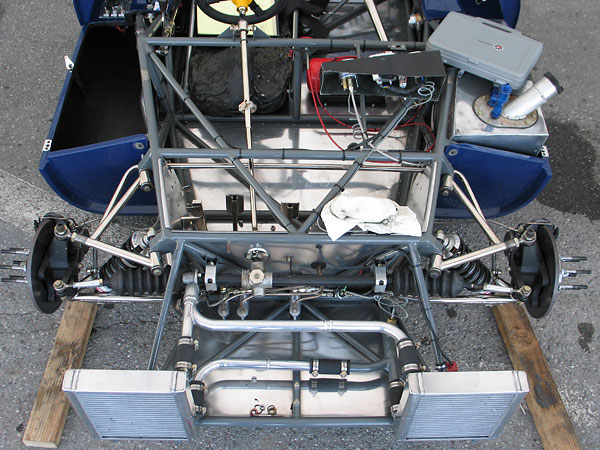
Hot engine coolant is routed to the radiators through the lower, lefthand, longitudinal frame tube.
The coolant return has been re-located outboard of the frame, probably to reduce driver temperature.
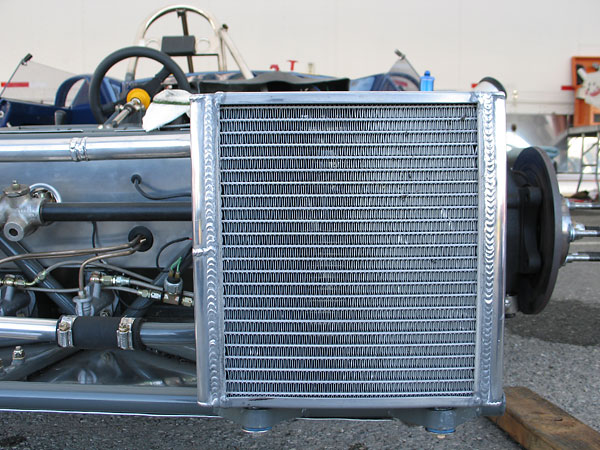
Dual custom aluminum crossflow radiators. Notice that they're plumbed in parallel, not in series.
Heat exchangers are most efficient when the difference between fluid and air temperature is maximized.
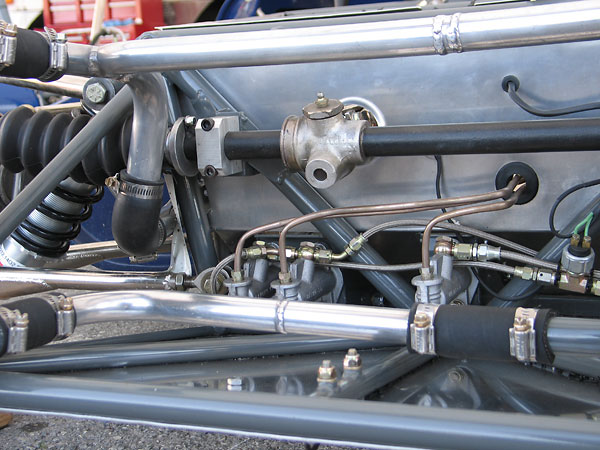
Girling master cylinders.
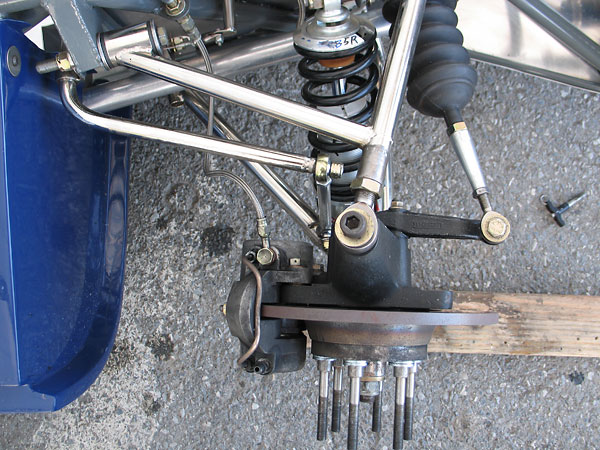
Lee Chapman Racing stocks brand new replacement front uprights and axles for the Elva Mk7 model.
KONI aluminum-bodied double-adjustable coilover shock absorbers. Girling AR brake calipers.
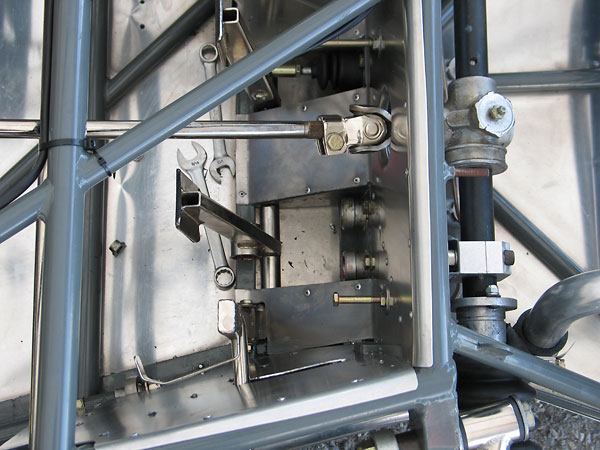
Heavily modified Triumph Herald steering rack, mounted on aluminum pillow blocks.
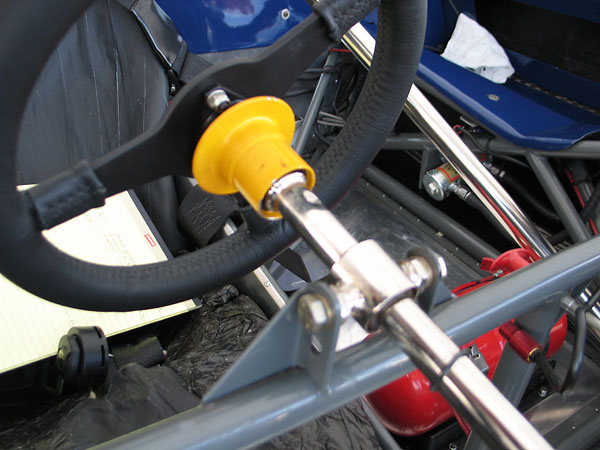
FIA technical specification Appendix J Article 255 (dated 01-01-2003) states: "The quick release mechanism
must consist of a flange concentric to the steering wheel axis coloured YELLOW through anodization or any
other durable yellow coating and installed on the steering column behind the steering wheel. The release
must be operated by pulling the flange along the steering wheel axis." (Pushbutton style quick release
hubs that don't meet this rule can typically be purchased for one-half to one-third the price.)
Enjoying this article? www.BritishRaceCar.com is partially funded through generous support from readers like you!
To contribute to our operating budget, please click here and follow the instructions.
(Suggested contribution is twenty bucks per year. Feel free to give more!)
Rear Suspension
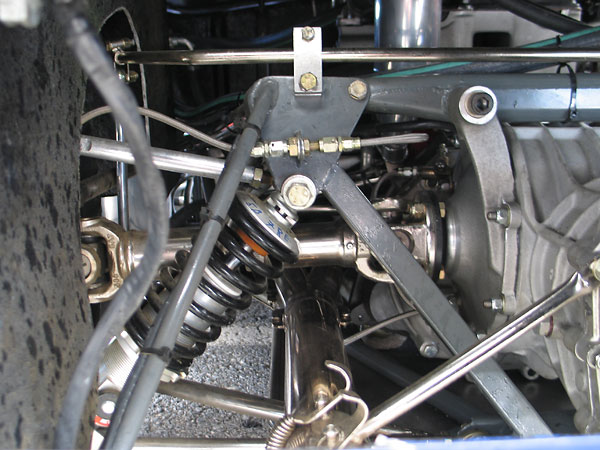
This KONI aluminum-bodied double-adjustable coilover shock absorber complete with shaped
Silasto bump rubber is vastly superior to the shock absorbers that were available in 1963.
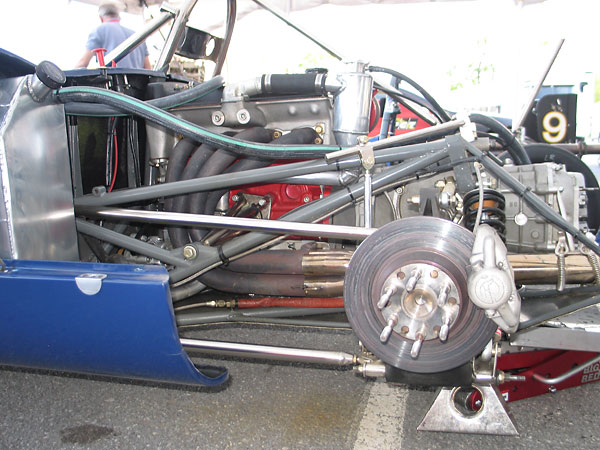
This rear suspension features inverted lower wishbones, single top links, and twin radius arms.
In 1963 this suspension layout was just starting to become de rigueur for racing cars.
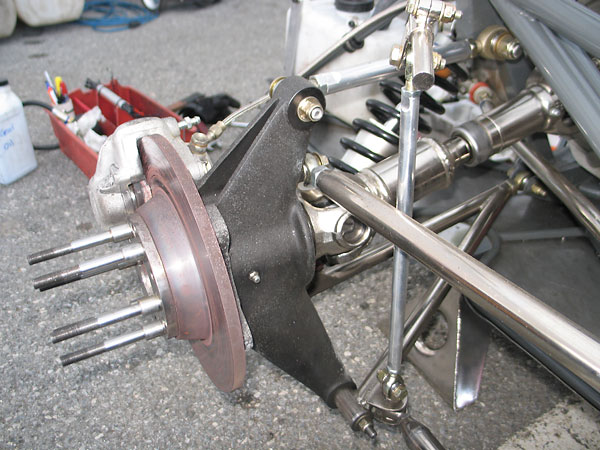
Lee Chapman Racing stocks brand new replacement rear uprights and axles for the Elva Mk7 model.
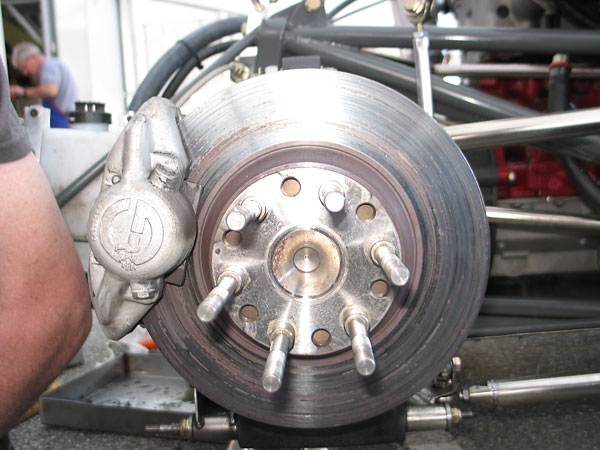
Girling D12R (or D14R, depending on bore size) aluminum calipers, used with solid rotors.
Interior / Roll Structure / Etc.
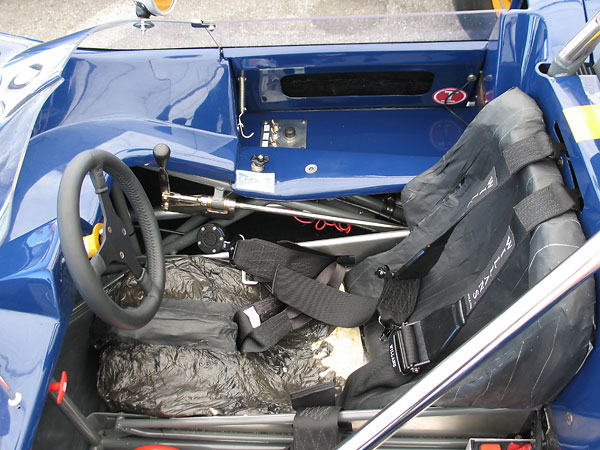
This custom-fitted driver's seat is a plastic trashbag half-filled with
catalyzed (hardening) spray foam and upholstered with gaffer's tape.
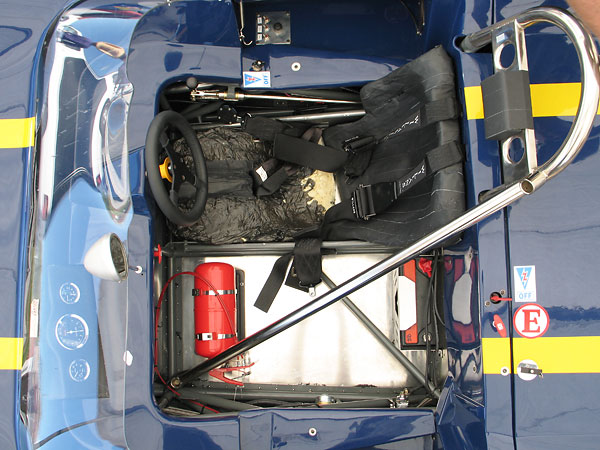
Bottom right: PowerSafe SBS sealed lead acid battery.
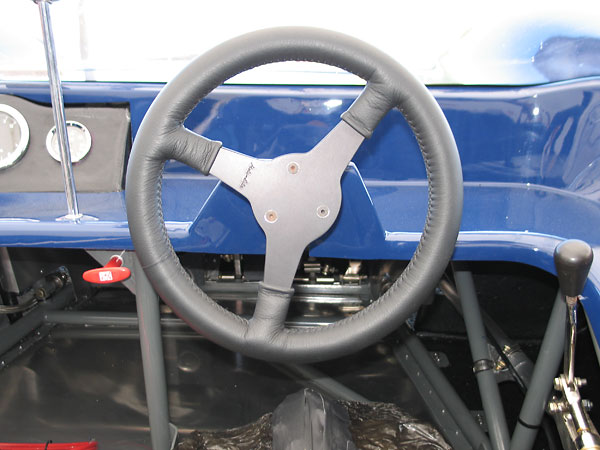
Moto Lita leather wrapped aluminum steering wheel.
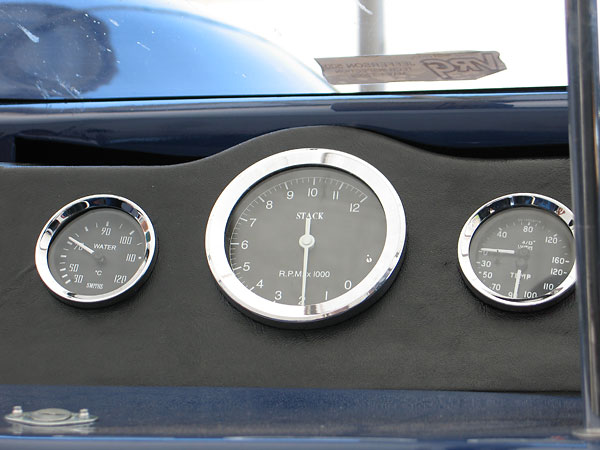
Smiths water temperature gauge, Stack tachometer, & Smiths dual oil pressure/temperature gauge.
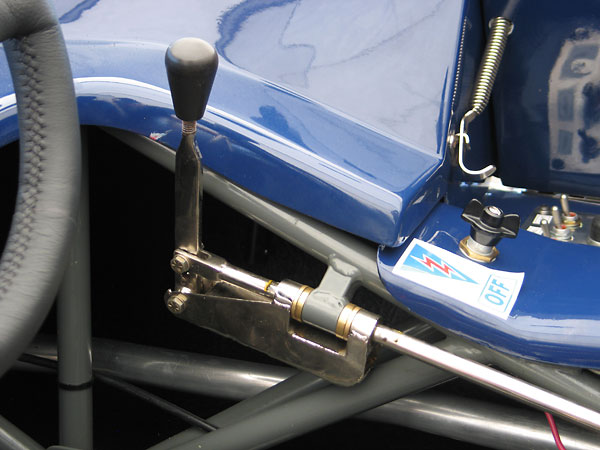
Elva Mk 7 gear selector linkage.
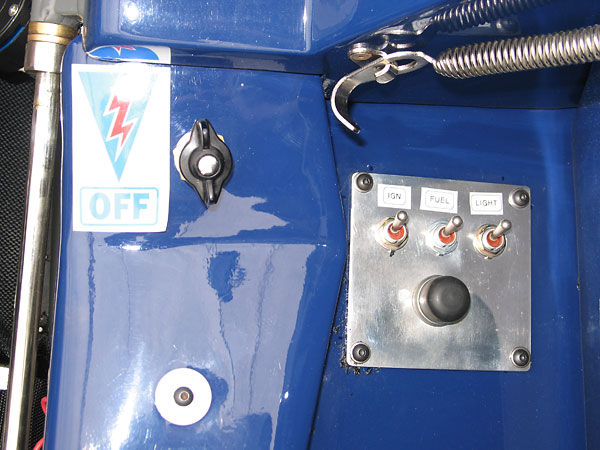
Lucas rotary battery disconnect switch. Ignition, fuel, and rain light toggle switches. Starter button.
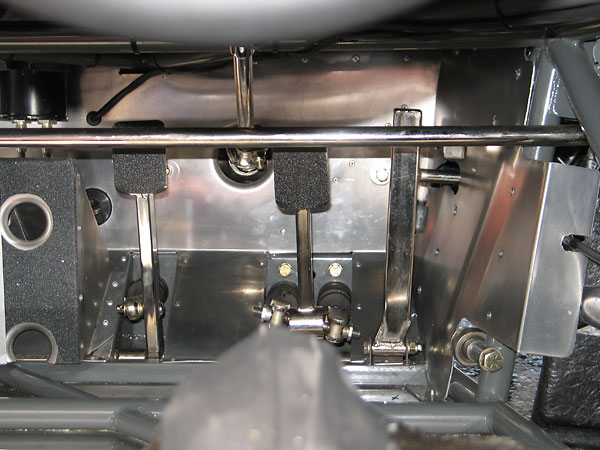
Pedal spacing.
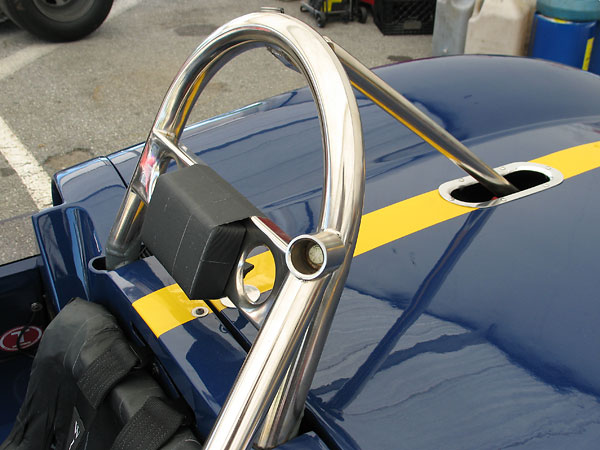
Roll hoop.
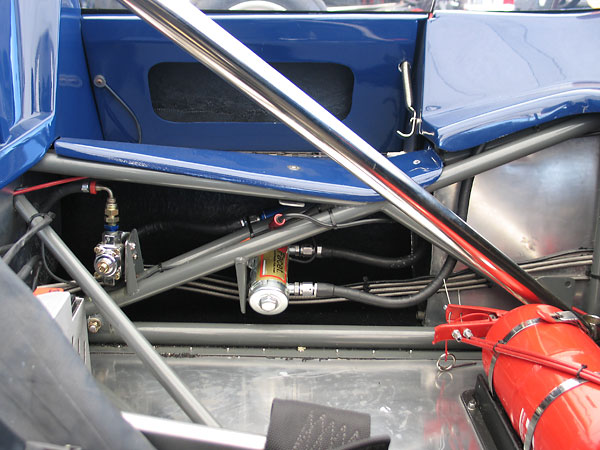
Center: Facet Bendix-style electric fuel pump. Left: Holley adjustable fuel pressure regulator.
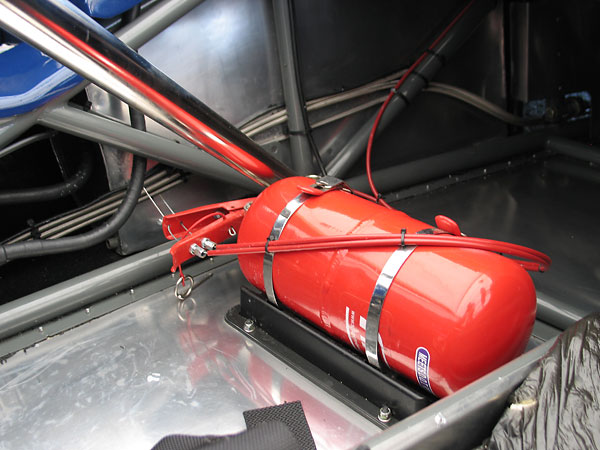
SPA AFFF fire suppression system.
Exterior
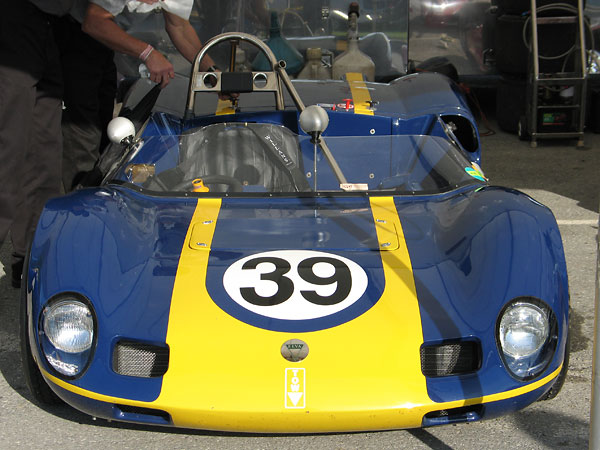
The Elva Mk7/7S was very successful in SCCA's G-Modified and F-Modified classes.
(Through the 1964 season, G-Modified = 750-1100cc & F-Modified = 1100-1500cc.
Starting in 1965, G-Modified = 850-1150cc & F-Modified = 1150-1600cc.)
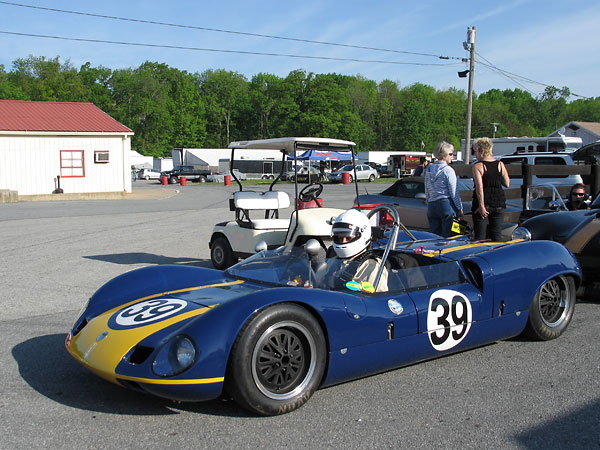
During 1965, at least sixteen different drivers entered Elva Mk7/7S racecars in "National" SCCA events.
Regional champions were invited to participate in the American Road Race of Champions (ARRC),
which was held at Daytona International Speedway on November 27th and 28th, 1965.
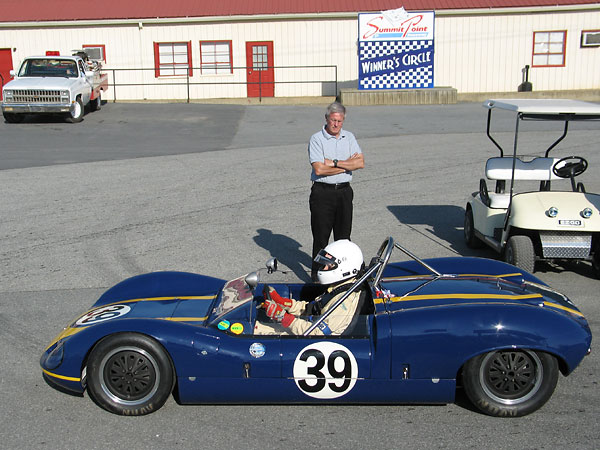
The 1965 ARRC results present an indication of Elva Mk7's place in the racing scene of its era.
GM Entries: Elva Mk7 (x3), Lola (x1), Lotus 23 (x2), Lotus 23B (x1), Merlyn Mk6A (x2), other (x4).
G-Modified Results: Lotus takes 1st & 6th. Elva takes 2nd & 4th. Merlyn takes 5th. Lola takes 7th.
FM Entries: Elva Mk7 (x2), Elva Mk7S (x3), Lotus 23 (x1), Lotus 23B (x3), Merlyn Mk6A (x2), other (x1).
F-Modified Results: Elva takes 1st, 3rd, 4th, 6th, & 7th. Lotus takes 2nd, 5th, & 9th.
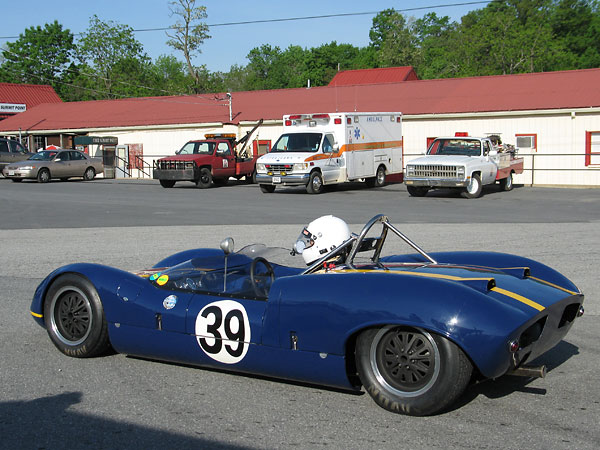
This color scheme recalls the Penske/Sunoco racecars of the late sixties and early seventies.
(Mark Donohue owned and successfully raced an Elva Courier before joining that famous team.)
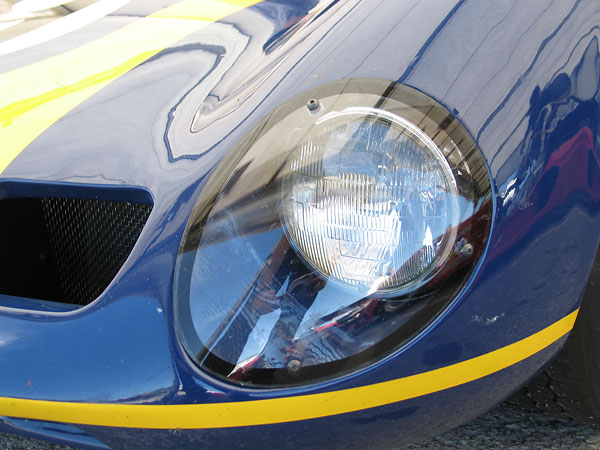
Perspex headlamp cover.
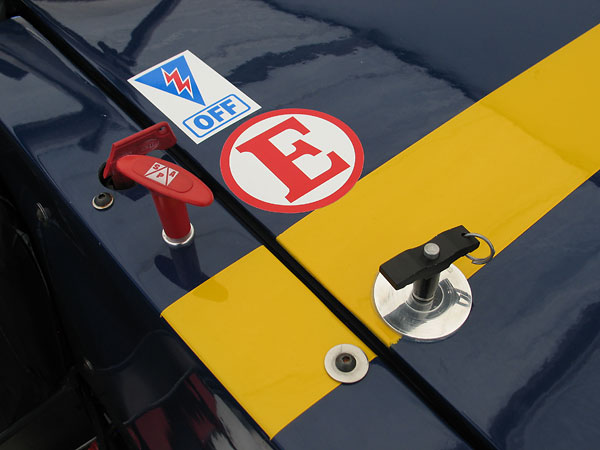
The device at right is commonly called a "pip pin". More technically, it's a single action quick release pin.
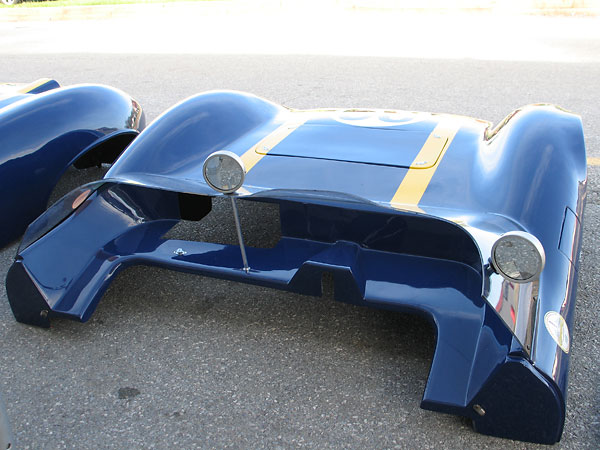
Elva Mk7 front clip. Those are GT Classic mirrors.
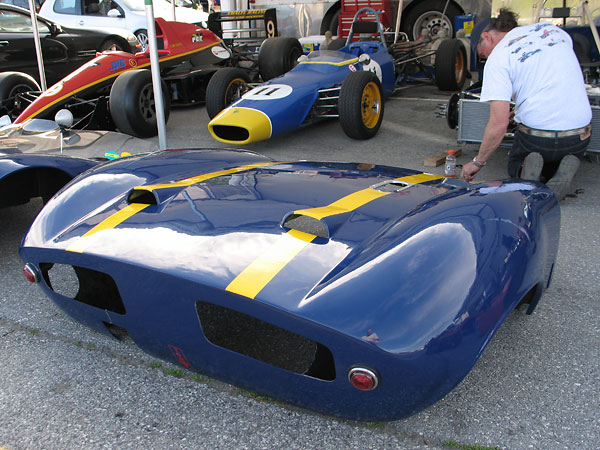
Elva Mk7 rear clip. (In the background, Bernard Bradpiece's other racecar is a Merlyn 11A Formula Ford.)
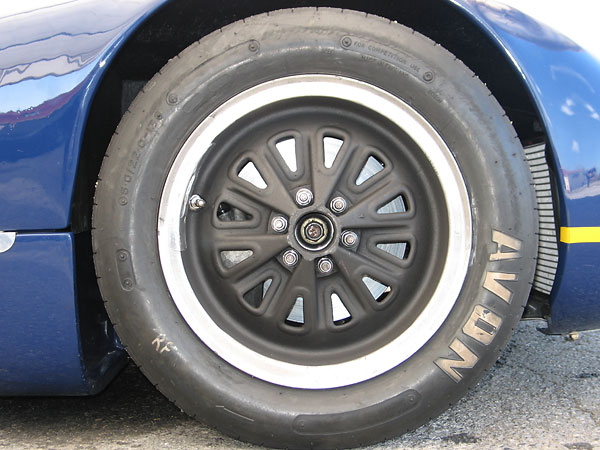
Reproduction Elva magnesium racing wheels from Lee Chapman Racing (13x6 front and 13x7 rear.)
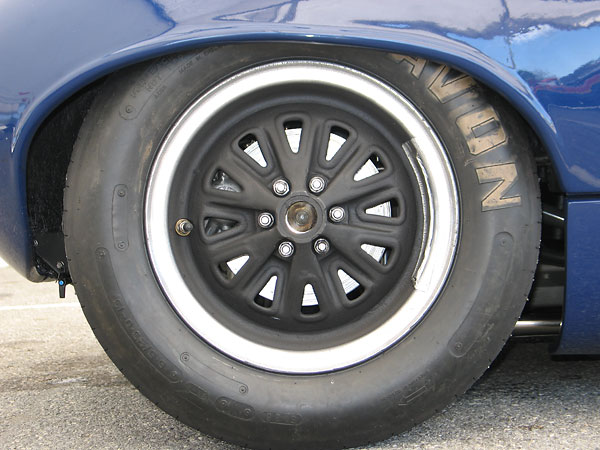
Avon racing tires (5.0/22.0/13 front and 6.5/23.0/13 rear.)
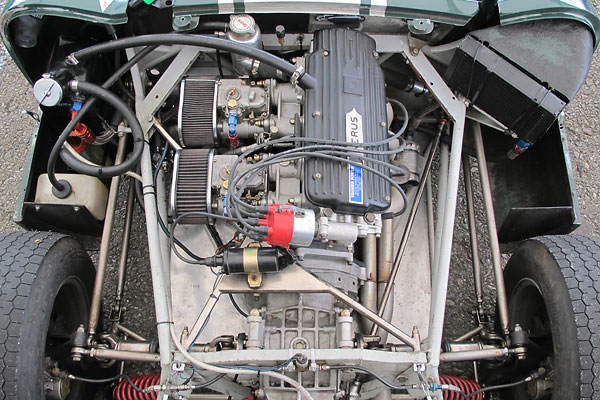 (Robert Paltrow's Elva Mk7S, as photographed by Curtis Jacobson for BritishRacecar.com) Are you curious to see how an Elva Mk7 compares to a Mk7S? You won't find those details anywhere else! We have close-up photos, almost ready to publish. Voluntary contributions from readers like you help fund our work. If you appreciate what we're building here, please toss some change into our tip jar! |
All photos shown here are from April 2010 when we viewed the Elva Mk7 at VRG's Jefferson 500
at Summit Point Motorsports Park, West Virginia.
Photos by Curtis Jacobson for BritishRaceCar.com, copyright 2012. All rights reserved.
| If you liked this article, you'll probably also enjoy these: | |||||
 |
Michael Oritt '59 Elva MkIV |
 |
Don Munoz '62 Lotus 23B |
 |
Bernard Bradpiece '69 Merlyn 11A |
| You're invited to discuss anything you've seen here on The British Racecar Motorsports Forum! | |||||
Notice: all the articles and almost all the photos on BritishRacecar.com are by Curtis Jacobson.
(Photos that aren't by Curtis are explicitly credited.) Reproduction without prior written permission is prohibited.
Contact us to purchase images or reproduction permission. Higher resolution images are optionally available.



